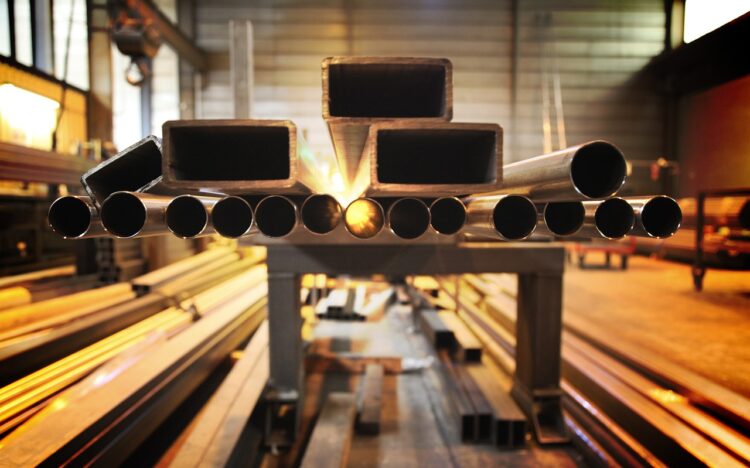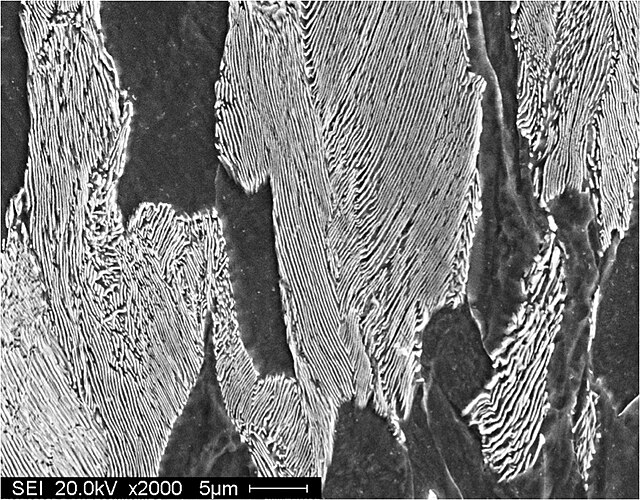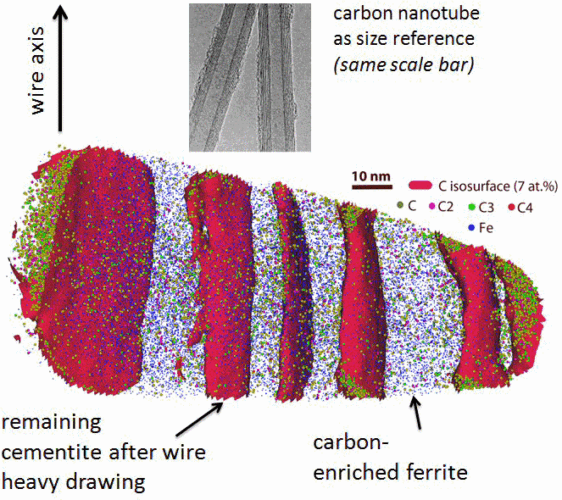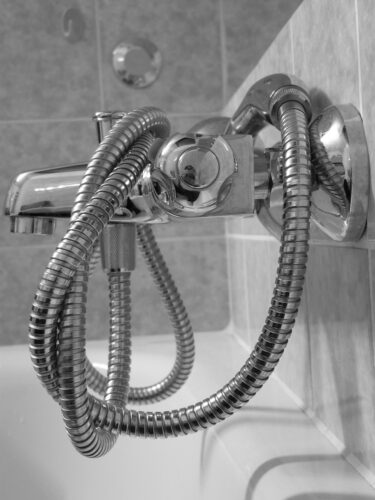Our Location
Pearlitic stainless steel is a type of steel that has a pearlitic lattice structure. This type of steel is known for its excellent thermal stability and outstanding resistance to corrosion, making it ideal for use in industrial settings that expose it to harsh environments, such as high temperatures, high pressures, and strong corrosion. Due to its exceptional performance, pearlitic stainless steel is used in various fields, including aviation, aerospace, nuclear industry, petrochemical, medical equipment, and more. This article will discuss pearlitic stainless steel’s composition, applications, cons and pros.

Table of Contents
Toggle“Pearlitic stainless steel” refers to a composite state of iron. This state is characterized by a pearlitic microstructure formed by the joint arrangement of thin layers of ferrite and cementite, resulting from a eutectoid reaction from austenite. The appearance of pearlite may be misleading as the individual lamellae within a pearlite colony are interconnected in three dimensions. In other words, a colony is an interpenetrating bicrystal of ferrite and cementite.
Pearlite, a type of microstructure, was named after the pearly phase constituent discovered by Henry Clifton Sorby, an English microscopist, and was identified by Henry Howe. It is composed of alternating plates of ferrite and cementite (Fe3C). A lamellar morphology characterizes its structure, and it forms through the eutectoid reaction. The distance between the lamellae is correlated with the cooling rate or the formation temperature. When cooled quickly or formed at low temperatures, the spacing is finer. Conversely, the spacing is generally coarser when cooled slowly or formed at high temperatures.

Pearlite is a microstructure that forms in an iron-carbon system when the system is slowly cooled at the eutectoid point in the Fe-C phase diagram at 723°C. A pure Fe-C alloy comprises about 88% ferrite and 12% cementite by volume. Pearlitic stainless steel is known for its toughness, and it becomes extremely strong when highly deformed.

SEM micrograph of etched pearlite, 2000X.
The production of pearlitic stainless steel consists of several processes:
The shiny look of pearlitic stainless steel is due to the pearlite colonies that form lamellae. When the material is treated with metallographic etching, the ferrite is attacked more vigorously than the cementite. The raised spacing of the cementite functions as a diffraction grating, causing light to diffract and giving the material a pearl-like appearance.
Pearlitic stainless steels are earth’s most robust and ductile commercial bulk materials. When viewed under a microscope, they have a distinctive appearance created by thin lamellar bands. The term ‘pearlite’ refers to the appearance of the alloy phase when studied under the microscope. It resembles the mother of pearl, a natural lamellar structure found in some shellfish. However, it is essential to note that the mother of pearl is produced through the natural deposition of successive layers rather than as a result of special treatment of a eutectoid mixture. Despite this difference, both materials share the trait of hardness and strength created by thin, subsequent layers of material.
Pearlitic stainless steel comprises carbon, iron, and other metals such as molybdenum, nickel, and chromium. Chromium is the most important alloying metal, usually in between 10% and 30% of pearlitic stainless steel. Adding chromium improves the oxidation resistance, corrosion resistance, and hardness of the steel. Additionally, pearlitic heat-resistant steel often contains other alloying elements like molybdenum (Mo), tungsten (W), niobium (Nb), titanium (Ti), and aluminum (Al) to enhance the steel’s performance further.
Besides the elements mentioned earlier, pearlitic stainless steel usually includes a robust constituent called vanadium (V). Vanadium enhances steel’s strength, hardness, and toughness while preventing excessive carbon accumulation. It also refines the steel structure and makes it more fine-grained. In high-temperature situations where oxidation is common, vanadium can improve steel’s heat resistance.

Pearlitic stainless steels can be categorized based on their carbon content, alloying element content, and heat treatment methods:
In addition, pearlitic stainless steel can also be classified according to the heat treatment method:
It should be noted that the classification of pearlitic stainless steel depends not only on the carbon and alloy element content but also on specific application requirements and desired properties. The above are just some very common classification methods.
Compared to other types of stainless steel, pearlitic stainless steel has some distinct physical properties. It offers a performance level between ferrite and cementite, with superior strength and toughness. Pearlitic stainless steel has a density of 7.85g/cm^3, a tensile strength of 750-900MPa and 180-280HBS, a yield strength of 310MPa, an elongation of 20-25%, and an impact energy of 24-32J. Regarding corrosion resistance, pearlitic stainless steel is better than ordinary 304 stainless steel and more affordable than nickel stainless steel.
Pearlitic stainless steel exhibits mechanical properties that fall between ferrite and cementite. This type of steel has higher strength, moderate hardness, good plasticity, and toughness. Its tensile strength (σb) is 770MPa, with a yield strength of 180HBS. The elongation at break (δ) ranges from 20% to 35%, and the impact energy (AKU) ranges from 24 to 32 Joules. The comprehensive mechanical properties of pearlitic stainless steel are better than those of ferrite or cementite alone.
The mechanical properties of pearlitic stainless steel are intermediate between ferrite and cementite. It has moderate strength and hardness and is not brittle due to the lower amount of cementite than ferritic stainless steel.
Pearlitic stainless steel replaces nickel with other elements like aluminum, copper, vanadium, and nitrogen. This stainless steel has excellent features such as high strength, good corrosion resistance, and low cost. Typically, it has two different surfaces: silver-white, also known as the “glossy pearlite” surface, and gray, referred to as the “matte pearlite” surface.
The mechanical properties of pearlitic stainless steel significantly influence its machinability. The phase mixture has 210 HV in hardness, 700 N/mm2 in tensile strength, and elongation at a break of 48%, which puts it in the middle range compared to other steel components. Due to its high hardness, pearlitic stainless steel’s abrasive wear is higher than ferritic stainless steel, resulting in higher cutting forces. However, pearlitic stainless steel has the advantage of having fewer built-up cutting edges and less stickiness, which leads to better surface qualities and more favorable chip shapes. Moreover, pearlitic stainless steel forms significantly fewer burrs, making it an ideal choice for applications where high precision and excellent surface finishing are required.
The microstructure and composition of pearlitic stainless steel can make it challenging to weld and machine. Carbon diffusion can occur during welding, especially in high-temperature operations or heat treatment. This can lead to the formation of decarburization or carburization layers, which can impact the base metal’s hardness and microstructure. To mitigate these issues when welding pearlitic stainless steel in dissimilar joints, it’s best to use processes that reduce the fusion ratio, such as large grooves, low current, and fast and multi-layer welding. Additionally, it’s advisable to weld long welds in sections.
When working with pearlitic stainless steel during welding processes that involve preheating, post-weld heat treatment, and dissimilar steel, it is essential to consider the steel’s hardenability tendency. Appropriate preheating must be done if the steel has a high hardenability tendency. Additionally, dissimilar joints of pearlitic stainless steel with high hardenability tendencies need post-weld heat treatment to prevent hardening structures, reduce welding residual stress, and prevent cold cracks.
It is important to note that welded joints in the fusion zone may become brittle and have a diffusion layer, particularly when welding large-thickness rigid components. To prevent this, a high nickel electrode can be used for surfacing welding on the groove surface of pearlitic stainless steel first, and then welding can be done.
During post-weld cooling, variations in the linear expansion coefficients of pearlitic steel and other materials can cause thermal stress, which may impact joint strength and thermal fatigue. This can be addressed by using appropriate system design and joint arrangement and adding a transition layer when necessary.
Lastly, the hardness of pearlitic steel can make machining more complicated, requiring suitable tools and machining methods to accomplish desired results while minimizing tool wear and preserving dimensional accuracy.
Heat treatment is a crucial process that significantly affects the properties of pearlitic stainless steel. It involves altering the microstructure and mechanical characteristics of the steel. The pearlite microstructure changes its composition and arrangement during the heat treatment process, resulting in hardness, strength, and ductility adjustments. Depending on the specific heat-treatment process used, such as annealing, quenching, or tempering, the steel’s hardness, toughness, and corrosion resistance could be tailored to meet desired specifications. For instance, annealing can refine the pearlite structure and enhance ductility, while quenching and tempering can increase hardness and strength. Therefore, heat treatment plays a pivotal role in optimizing the properties of pearlitic stainless steel for various applications.
Here are five typical applications of pearlitic stainless steel:

Advantages of using pearlitic stainless steel in manufacturing include:
Limitations of pearlitic stainless steel in manufacturing involve:
Cooling Rate :
Pearlitic stainless steel: When austenite is cooled slowly enough, it forms ferrite and cementite, which are mixed intimately. The mixture takes on a lamellar form, consisting of alternating ferrite and cementite layers. This particular microstructure is known as pearlite and is commonly found in pearlitic stainless steel.
Martensitic stainless steel: When austenite is cooled rapidly, there is insufficient time for all its carbon atoms to diffuse and form cementite. Consequently, the carbon atoms become trapped inside the iron unit cell. Since iron does not have adequate interstitial space, the unit cell becomes distorted with additional carbon atoms. This distorted lattice structure, known as martensite, takes on a body-centered tetragonal shape.
The microstructure and mechanical properties of pearlitic stainless steel fundamentally differ from those of ferritic stainless steel. Ferrite, a soft and ductile material, constitutes most ferritic stainless steel, whereas pearlitic stainless steel combines ferrite and cementite. Unlike ferrite, pearlite is more brittle and tougher. A higher carbon content in steel produces more pearlite, resulting in higher bulk strength. Due to its unique microstructure and composition, pearlitic stainless steel exhibits different mechanical properties than ferritic stainless steel, making it more appropriate for applications requiring excellent wear resistance and hardness.
Discover the fantastic properties of pearlitic stainless steel! This exceptional material is versatile and can be used in various applications. Its specific composition makes it highly resistant to wear and tear, making it perfect for use in high-stress environments where other materials quickly wear out. This article guides you to the many benefits of pearlitic stainless steel so you can confidently choose it for your next project.

